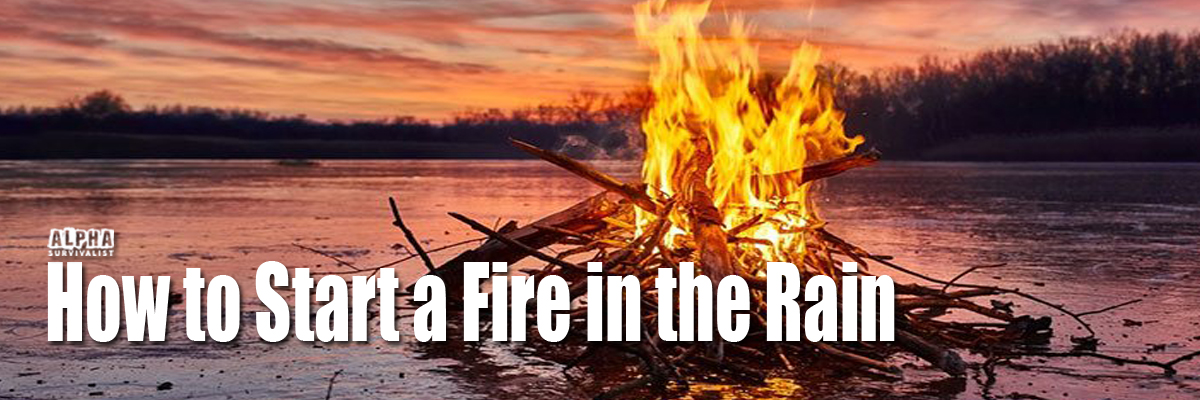You may be asking yourself why you need to know how to start a fire in the rain? Chances are that if you’re ever going to get stuck in an emergency situation you’ll also experience bad weather along the way. They say that when it rains it pours, and sometimes that might mean literally!
Rain or shine, you need some way to start a fire and most survival instructors will tell you that you should carry tools to start a fire in two primary ways and two secondary ones.
Rain is going to make it hard to light matches (although waterproof matches would help) and if colder temperatures come with the moisture, it’s also going to be nearly impossible to start a butane survival lighter. However, the best way to light a fire in the rain is to use a ferro rod and some good tinder, like char cloth. All that means nothing if you haven’t found a good location for your fire that provides as much shelter as possible.
How to Start a Fire in the Rain – Shelter is Vital!
The best way to shelter your tinder is by setting up a windbreak this will at least stop gusts from the upwind side. This will stop wind from putting out your fire directly, but any wind that suddenly comes from another direction could still put it out. Building a C-shaped windbreak will help reduce the chance of that happening.
You can build a windbreak using rocks, debris or even wet plant matter. Whatever material you use to build your windbreak don’t build it too high, since you still need to let the smoke out.
Try building your fire underneath a tree if at all possible, since the branches can help to at least scatter the rain. I know that goes totally against our advice about where to and where not to build a fire, but rules change when it’s raining! Pick a large evergreen tree that forms a sort of a natural tent. Crawl under the lowest branches and cut off any that might be getting in the way.
Unfortunately, there’s always a risk that you could start the trunk on fire if you’re not careful. You should be able to avoid this by simply keeping the fire under control once you have it lit.
However, at this point, you’re probably more concerned with blocking the rainwater enough so that you can get a flame in the first place.
Don’t try to light any kindling that’s wet, since you won’t be able to build a hot enough fire this way.
You’ll need to collect dry organic material and put it in your designated shelter area if at all possible.
Finding Dry Fuel for the Fire
Everyone traveling with a bug-out bag should have at least some tinder in it. You probably should have some char cloth with you too.
However, assuming that you don’t have these on hand, you can often find drier dead branches under the trunks of pine trees. These usually stay relatively dry even in a driving storm.
Take a look underneath dead trees. You’ll also want to explore any stands of timber that have been uprooted, since these might hold dry wood as well.
Snap off some bark from these trees, since it should usually burn pretty well. Any fuel you use for your fire once its built doesn’t have to be quite as dry as kindling or tinder does, but drier material is still better.
In a worst-case scenario, though, you can start a fire in the rain even if you only have wet wood.
How to Start a Fire in the Rain without Dry Fuel
A combination of cotton balls, dryer lint and petroleum jelly can burn for hours. You’ll want to put this in your bug-out bag because you can often light it on fire and then spread said flames to a piece of wet wood.
Consider adding a combination of black powder and nail polish remover to your bag as well. You need real conventional gunpowder, like the kind that’s used in traditional Chinese fireworks, rather than modern smokeless powder used in bullet loads. Nail polish remover made from oil contains acetone, which acts as a solvent for black powder.
Put on some gloves and then roll up a golf ball-sized amount of black powder. Pour some nail polish remover on it and work it until it has the consistency of wood-filling putty. Fold it over and over again until it has a large number of layers. Once you have it tightly packed, you should put it into an airtight canister that’s light enough to carry with you.
Ping-pong ball sized chunks of this putty can burn at more than 3,000°F for over 3½ minutes without too much difficulty. As a result, it can start even fairly damp pieces of wood on fire.
How to Start a Fire in the Rain Using an Accelerant
Gasoline, siphoned out of a motor vehicle, can be used to start wet pieces on wood as well. In a survival situation where you could theoretically repurpose something you would have used in a more normal setting, you could also set fire to paint thinner or turpentine.
Regardless of which method you use to start a fire, though, you’ll need to make sure your fire is protected from falling rain if you plan on keeping it burning for any length of time.
Finally…..
Knowing how to start a fire in the rain is one thing, actually putting that knowledge to use is a tad more difficult. Whenever you have the opportunity, get out there and practice. As with everything else to do with mastering fire making skills, perseverance and practice will be key to your success.


